The 2015 MacBook Review
by Ryan Smith on April 14, 2015 10:15 AM ESTThe MacBook's Design
In terms of overarching design, the MacBook is both treading new ground and much of the same. As we’ve mentioned before, the big promotional point for the MacBook is how small it is. And yet at the same time Apple has retained more or less all of the stylings that have come to define the modern unibody MacBook family design. The end result is a laptop that looks and acts almost exactly like a smaller MacBook Air or Retina MacBook Pro.
This leads to the new MacBook having all of the contours and finishes we have come to expect from a MacBook family laptop. The all-aluminum unibody design continues to impress and holds up well even with the MacBook’s smaller form factor. For the MacBook in particular it serves two goals for Apple, the first being to give the device a premium feel, but the second is to serve as a means of cooling the MacBook.
For one of the biggest changes in the MacBook compared to the MBA is the fact that this is a completely fanless design. There are no fans or even vents on the laptop to move heat or hot air; the closest thing that comes to a vent is the grating at the top of the laptop, above the keyboard, which houses other items such as the speakers. Otherwise all real heat dissipation is carried on by the aluminum case itself, which in turn is made practical by the use of the ultra-low power Core M processor. This also means that the MacBook is silent, containing no motorized parts and the only moving parts being the keyboard keys, the trackpad, and the screen hinge. The MacBook Air for its part was seldom loud, but for whisper quiet there’s no topping fanless.
Moving on, Apple retains the sloped design of their MacBook Air, leading to this MacBook having a similarly variable thickness. At its thickest part, towards the rear of the laptop, it’s just 13.1mm thick, and towards the front of the laptop this narrows to just 3.5mm. As with the MacBook Air I’m not sure if this sloped design is really necessary or beneficial versus a flat design, or if Apple does it merely to show off, but if you like your wrists low to the table, then at 3.5mm at its thinnest point, the MacBook is among the thinnest. Meanwhile the fact that the edges are also curved makes the MacBook deceptively thin overall, as even at 131mm it doesn’t feel even that thick when grabbed from the edges.
Perhaps the most notable – and admittedly cosmetic – change from the MacBook Air is the Apple logo on the top of the laptop. The iconic lit white logo is gone in favor of a black mirrored logo in its place. Apple doesn’t specifically address the logo, but with the tight constraints on both thickness and battery life – Apple needs to get 9+ hours off of a 39.7Wh battery driving a 12” Retina display – I suspect Apple finally sacrificed the logo to further save on power.
The other big cosmetic change here is the color of the aluminum laptop body itself, which in a first for an aluminum Mac now comes in multiple colors. Further reinforcing the crossover nature of the device and its place between a tablet and a traditional laptop, the MacBook comes in the current iOS device colors of Silver, Space Grey, and yes, Gold. Silver will be the closest to the traditional aluminum look, Space Grey is as close as you’ll get to a black MacBook, and Gold continues to defy our own expectations and be a popular color on Apple devices. Overall the current coloring is limited to just the MacBook, but given Apple’s drive for style, I wouldn’t be all that surprised if this eventually came to the Retina MacBook Pro as well, though perhaps not the MacBook Air for cost reasons.
I also want to quickly call attention to the lid hinge in the MacBook, which is something I feel Apple has done very well with. In such a thin and light laptop the percentage of the laptop’s weight that’s carried by the screen/lid has gone up, which risks the laptop becoming top-heavy. Not only has Apple managed to avoid a top-heavy design, but the hinge is as perfectly balanced as I’ve ever seen. The hinge is just loose enough that even trying to quickly lift the lid can’t really torque the laptop’s base up, and yet no looser than it needs to be. As a result the hinge still offers plenty of resistance without it being a problem for the relatively light base, and the laptop can easily be held at 90° without the lid dropping.
Moving on, we’ll cover the ports in depth a bit later, but we did want to quickly note the MacBook’s choice in ports while discussing the design. In another example of Apple minimalism – or maybe just another sign of the tablet/laptop crossover – the MacBook only has 2 ports: a USB Type-C port, and a 3.5mm combo jack for audio. All wired power, data, and video is routed over the single Type-C port, and the laptop itself is thin enough that there’s not room for something much larger, at the very least not without making the laptop thicker or eliminating the base’s curved sides. This makes the MacBook very much like an iPad, with its single Lightning port and a 3.5mm combo jack, and has some definite repercussions for usability.
With regards to internal design there’s not a lot we can say at this time – Apple doesn’t like us disassembling review samples – but in lieu of the eventual iFixit teardown, Apple has posted a handful of sanitized shots of the MacBook’s internals. Apple is keen to show off the MacBook’s miniscule logic board, which is only 1/3rd the size of the 11” MacBook Air’s board. Much of this is enabled by the use of the Core M processor, itself using an especially small package to leave room for other components. This is combined with a highly integrated design that sees the RAM soldered on the board, and I suspect the SSD as well, meaning virtually nothing here is replaceable short of the entire logic board itself. In any case, along with this Apple has forgone some of the 3rd party chips like Intel’s Thunderbolt controller, which reduces to a minimum the number of chips they need alongside the Core M processor.
Update 04/15/2015: The iFixit MacBook teardown is in, giving us some excellent shots of the logic board. These pictures show us just how little is there beyond the Core M CPU, the RAM, SSD, a couple of extra controllers, and the necessary power management hardware.
With such a small logic board, Apple has filled out the rest of the laptops internals with batteries, 39.7Wh worth to be precise. This ends up being just a bit more than the 11” MBA’s 38Wh battery, again despite the smaller overall footprint, and is a result of Apple’s use of their new layered lithium polymer batteries, or as Apple likes to call it, their terraced, contoured battery cells. Overall LiPoly has slightly lower energy density than Lithium Ion, however in return it’s a more malleable medium, allowing for greater shape customization, which is what Apple is taking advantage of here. The end result is that Apple is able to better fill out the sloping, rounded case of the MacBook with battery cells by terracing them, squeezing out what little space would have otherwise remained.
Taken in overall, the MacBook has a distinct iOS-device feel to it at times. This is most immediately apparent from the selection of chassis colors, but digging deeper it extends into the electronics and internal design choices as well. Pairing a relatively large screen with a small logic board and filling out every nook & cranny with batteries is very much the iPad way of building things, never mind the fact that the Core M processor itself is designed in part to be a high-end tablet processor. Then of course is the port selection: just a single combined power/data port, and then the 3.5mm jack for audio.
The end result is a device that has an interesting laptop/tablet crossover design to it. The MacBook is still without a doubt a Mac laptop, but it’s also more like an iOS device than anything before it. Consequently while it’s still primarily meant to be used as a laptop – just a very portable, very light one – it’s also clear that Apple envisions it being used like a tablet. To be charged overnight, carried around and run during the day, and then put back on its charger for the night.


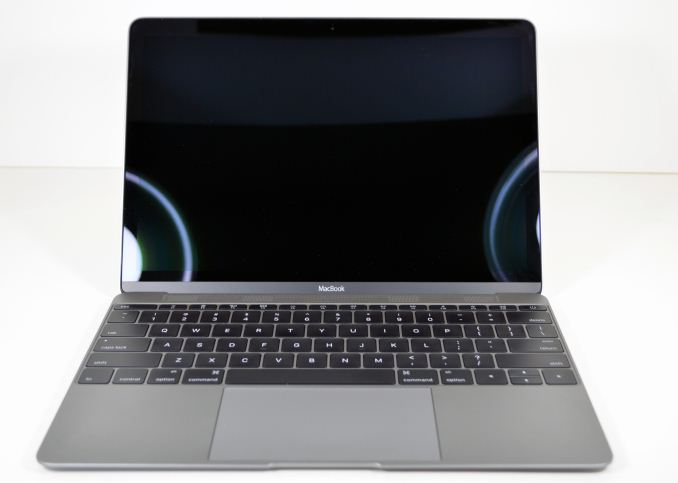
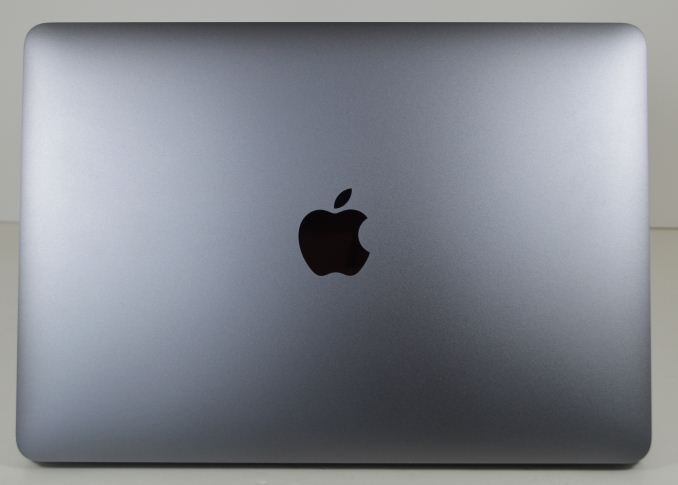
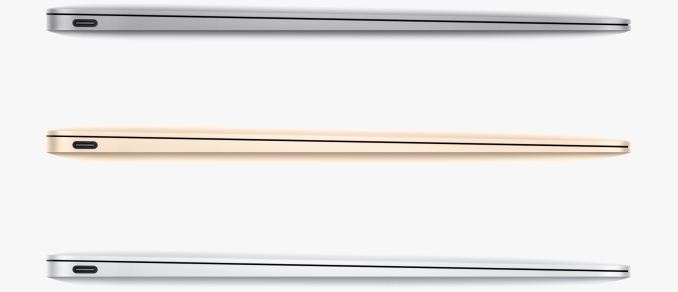
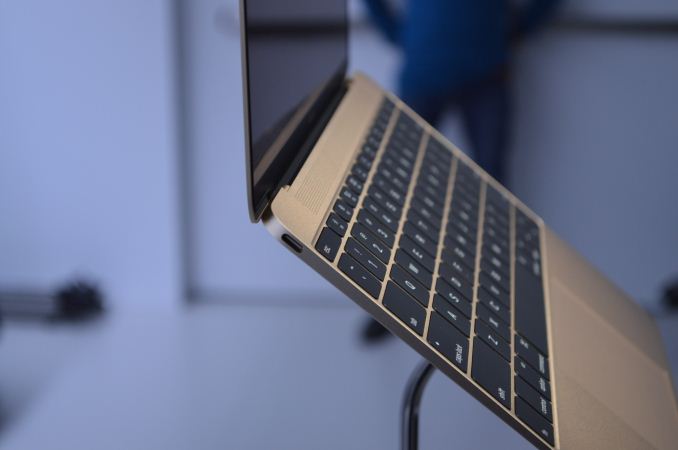

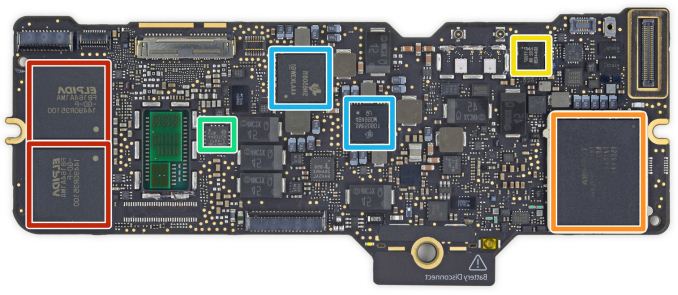

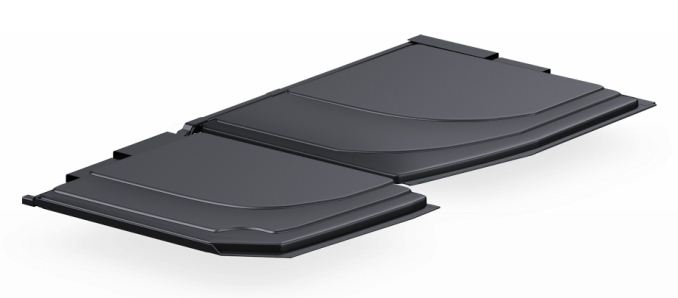








354 Comments
View All Comments
xchaotic - Monday, April 20, 2015 - link
They won't let you do that due to planned obscolesnce by both Apple and Intel. 16GB RAM and 1TB SSDs will be the max for quite some time.shompa - Friday, April 24, 2015 - link
One point about Intel/ARM. Intel Core-M 82mm2 1,3 billion transistors. Cost about 280 dollars + you have to buy Intel motherboard chips. Apple A8X is 132mm2 3 billion transistors. It cost Apple about 20 dollar to manufacture that. (on the market 130mm2 ARM SoCs cost about 50 dollars unsubsidized). When will the techpress and IT experts point this out? How can something that cost Intel 50% less than A8X cost the customer 20times more?The Macbook have an insane price but Intel is at least 400 dollar of that problem.
This is why we need to move away from X86 to ARM. (and Apple will move to ARM because they controll the OS/Hardware = they can add anything they want into the SoC. Huge parts of the A class SoCs are Apple specific stuff like Siris DSP, the visual processor, security enclave/TouchID and so on. About 30% of die area today. Imagine if Microsoft started to do custom ARMs/(or AMD X86) for their Windows. That would add value to the customer and make people buy MSFT hardware because they want to (not because they are forced to, like today with their OS)
One of the main problem is "capitalism". A good (older) company have 10-12% profit on what they sell. Simple math: 10% on a 500dollar intel is more than 10% on a 25 dollar ARM.
Intel is however a monopoly today. If I want a fast laptop: They are the only choice. But Intel is doing the same mistake as Sun, IBM, PA-RISC, PPC, DEC-Alpha, MIPS and all other fun CPUs have existed in history. (Because: let me tell you a secret: X86 have never had the fastest/best CPU in history. They had Windows + where cheap/good enough. Thats why Intel almost had no share in the server market. 2005/6 intel slashed Xeon prices to sub 300 dollar = why buy a RISC chip that is twice as fast for 4000 dollars? In under 3 years intel managed to get over 50% of server revenue. Today its about 80%. But its because Intel charges 4000 dollar for their xeons. History is repeating itself)
ixproval - Monday, April 27, 2015 - link
Anyone else notice that the article implies a comparison to the current 11" MBA (2015, Broadwell), there are no performance numbers for that model (or the 2015 13" MBA for that matter)? The latest comparisons on the majority of the performance graphs are the early 2014 13" MBA and the mid-2014 rMBP? At first I was wondering about release dates but they were announced at the same event. Did you guys just not have a 2015 11" MBA available for comparison? I apologize if I missed a reason for the omission in the article text.tipoo - Saturday, May 2, 2015 - link
So the UX305 uses a lower end cheaper Core M, but since it throttles less it ends up performing better than the Macbook...That's a bit disappointing. If they gave it a bit better cooling it would have had the better performing chip all around.HooDude - Sunday, May 3, 2015 - link
I bought one of these with the 1.1 ghz CPU. The fit and finish of the laptop is great, it's a beautiful device. However, it is terribly slow and the keyboard is awful. It lagged hard when I would try to scroll PDF files in preview, and typing on it was fatiguing to my hands and felt like I was typing on a table top instead of a keyboard. I ended up returning it because of these faults.Agrou - Tuesday, May 5, 2015 - link
Any news/details about the MVNe controller ? Does anyone knows on what it is based ? I want to run natively a linux distro on my macook air but the SSD is not seen. I want to try to load the controller's driver apple used to integrate on the ship.Remark : they also put this controller on the 11 inch model with core i7 I do have APH0128 in OSX HW informations.
Clorex - Monday, May 11, 2015 - link
Regarding the display's white point:"The goal here is 6504; the MacBook hits 6828, reflecting the fact that it’s just a bit too red and just a bit too light on blue."
I think it should be the other way round: the display should be bluish with a colour temperature of 6828 K.
EOL - Monday, May 11, 2015 - link
About the shallower keyboard: the keyboard MacBook Air (mid-2011, at least) does have a problem that the new butterfly keyboard might solve: key corners can quickly become imprinted onto the screen. This is a slightly annoying when watching videos, as the marks are quite visible, with a black background. Hopefully the new keyboard will prevent keys from damaging the screen, this time.birowsky - Tuesday, May 12, 2015 - link
can i just buy a force touch trackpad somewhere? i wanna put this beauty in my 15" rMBPAnthLC - Saturday, June 13, 2015 - link
I think it a great review and very helpful.I am planning on buying either this MacBook 12" or HP XPS 13". I do prefer Apple cause will work better together with my iPad and iPhone. Apple do make good solid devices and provide frequent updates. I need something similar in size to my iPad and light.
My concerns with the MacBook relate to performance, first gen fanless, the one USB-C port and the keyboard. While with the HP by all reports the fan can be irritatingly noisy, lack of HP fixes, updates, device driver issues and priced $100 more then the MacBook.
I primary use the IPad as my stock home computer and like a lot of people it is all I need. But I have hobby that require a PC application software. I don't have a real preference Mac or PC will do. But windows 8 is a turn off. Luckily for me the software works on both platforms.
The review has help me realise the performance should be fine to run standard PC applications. The single USB-C port was a concern because the software I plan to use requires a USB dongle.
But I haves learned there are solutions such as Infiniteusb which will actually overcome the single port problem. (http://getinfiniteusb.com) actually mean one port will probably be better.
Some people say well you have to carry the dongle, but the thing is if you have the need to plug in accessories well you will be carrying more then just the laptop whether there is one or more ports. Which to my mind makes the whole point mute. The daisy chaining of USB-C is cool too.
I like the idea of fanless. On the Internet and HP's own website user reviews suggest the HP XPS has some design fault, a noise that can be quiet annoying. I don't believe has been addressed.
In Australia the base HP XPS is about $100 more then thie base MacBook 12".
So I plan to get the MacBook 12".
I was thinking maybe the MacBook Air 13" but when you add on the upgrade to 8gb and 256gb HD equivalent of the base MacBook 12", there only $100 difference. I would rather a a Retina display. I also looked at the old MacBook Pro 13" but same price and I prefer the smaller footprint of the MacBook 12".
So I thought it may be interesting to post why I decide to buy the MacBook over the HP.
For me and a lot of people we don't want a high powered laptop with all the bells and whistles. Apple have squarely filled the gap for users like me who primarily use a iPad but have a need for a portable PC.
I did find it telling that I could buy a 15" laptop from Dell cheaper then their own HP XPS and 15" had better specs. It does suggest this is what people are buying and wanting. I mean a couple of years ago bigger laptops were the expensive ones.
Lastly there is a premium in price for these small laptops which is to say a opportunity for other manufacturers to come along and deliver similar device at a cheaper price point.